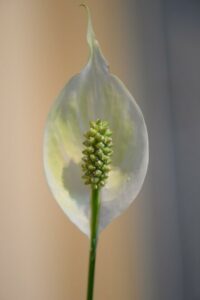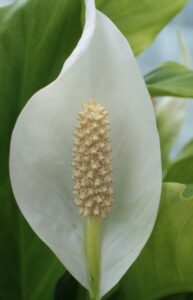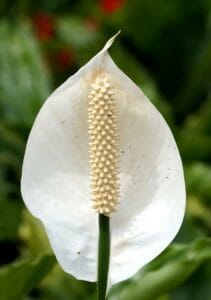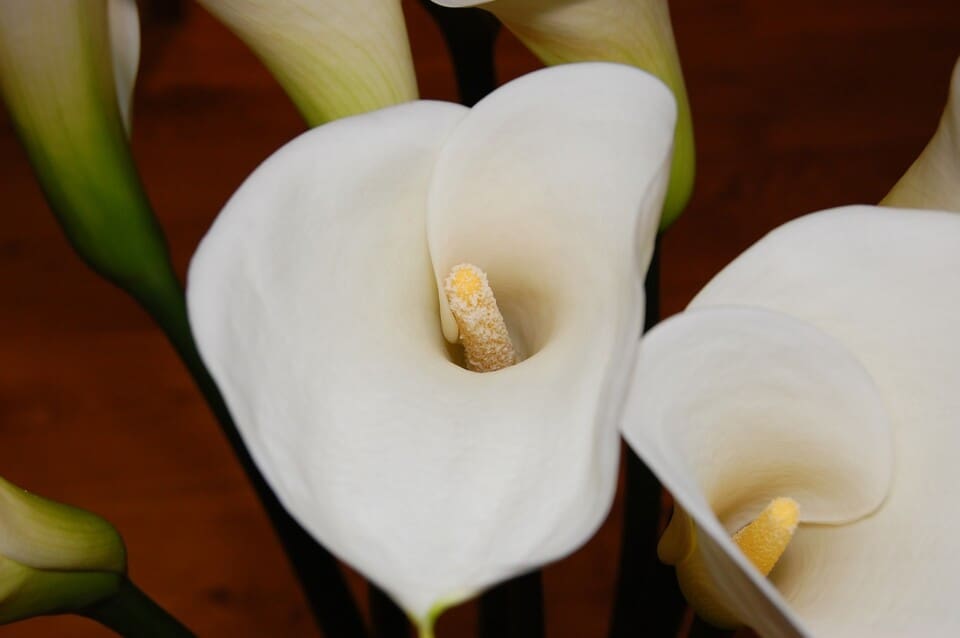Some links in the post are affiliate links and I get a commission from purchases made through some links found in the post.
Peace Lilies (Spathiphyllum) belongs to the Araceae family which is native to tropical regions. It is commonly found in places like south-east Asia and in the more tropical parts of the Americas.
It is interesting to note that Peace Lilies are in fact not lilies at all, they are evergreen herbaceous perennials which are also called ‘closet plants.’
Now right away that should alert you to the fact that the Peace lily may have different light requirements, and indeed they do.
The Peace Lily has large leaves of between 12-60cm in length and around 5 – 20 cm across. Its flowers are white or yellowish in colour.
You will be pleased to know that they do not need large amounts of light to grow well – although they do need some light, as do all plants. These plants are evergreen and tropical and thrive on the forest floors.
A peace lily needs dappled light and consistent humidity with moisture. They can also do well in fluorescent lighting, incandescent lighting, LED lighting, horticultural grow lights and halogen lighting. For our Peace Lily to be happy, we need to replicate these conditions.
It is true that Peace Lilies can be somewhat temperamental at times, especially if they do not have their requirements met, but we’re going to cover the best ways to keep Peace lilies happy.
An interesting point to note is that Peace Lilies are on the list from NASA for plants which keep our air clean. Even better news for gardeners of any level is that they are easy to maintain.
With a little insight you can keep your Peace Lily alive and thriving for many years.
What Type of Light Does my Peace Lily Need?
Apart from natural light which we receive from the sun there are several other sources of light which will make suitable choices to grow Peace Lilies.
Fluorescent Lighting
 This is the most common artificial light used for houseplants. It is also the most economical.
This is the most common artificial light used for houseplants. It is also the most economical.
You can normally buy the bulbs at any hardware or DIY store, and they are simply screwed into regular light sockets. These bulbs stay cool enough so they can be placed close to plants with no damage.
The generic fluorescent light bulb is higher in the blue wavelengths so if using them for your plants you may want to opt for a mix of cool and warm bulbs or invest in ‘full spectrum.’
A good rule of thumb when using them for plants is to err on the side of cool white. These should be placed about 30 cm away from your plants.
Incandescent lighting
Because of the amount of heat these give off they should be placed further away from your plants. These bulbs give off more red wavelengths and are useful if you want to encourage a plant to bloom.
LED Lighting
This is another energy efficient source of light which is also low heat. When buying these bulbs, you should look for those that produce both red and blue wavelengths.
These are most used in horticulture and are slightly different to regular LED lights for general usage.
Horticultural Grow Lights
These are normally shaped in long tubes and used in fixtures.
They are great for blooming some plants like African Violets and they contain a complete spectrum of wavelengths for this. These are also used to start propagating some hybrids.
Halogen Lighting
Although these are also suitable for using with plants, they do give off a lot of heat and are also less energy efficient than other fluorescent lights.
However, if you cannot get hold of any other artificial lights, then they can be used with care.
You may also like: How Big Does a Peace Lily Get
So, What Light does the Peace Lily Need?
Peace Lilies light can come from several different sources, including fluorescent light. What Peace Lilies do not want is direct sunlight.
Remember the forest floor where they live in dappled light all the time. That’s what we need to replicate for your Peace Lily to thrive.
Direct light is when your plant is placed on a window ledge or in the garden with nothing coming between the plant and the sun.
Indirect light is when there is something, like a mesh curtain or the leaves of higher trees which come between your plant and the sun.
There is also a difference between summer and winter light. Most plant grow well in summer and spring and then go into dormancy in the colder months.
In the hotter months the sun is more intense and shines for longer compared to the winter sun which is less intense with shorter days.
Your Peace Lily needs bright to medium indirect sunlight. It can and will also do well with artificial lighting if you cannot provide natural sunlight for it.
If you have a house or apartment where it is not possible to provide indirect sunlight, then opting for artificial light is an excellent option.
What about Dark Rooms?
You may think that your plant needs either a bright windowsill or artificial light to grow, but in fact there are several situations in any home where there is simply not enough light to grow most houseplants.
You may have a room where due to overhanging trees, the light coming into the room is vastly reduced. In fact, many homes have a room where there is reduced light.
If you still want to grow a plant in rooms like these, then you should seriously consider the Peace Lily.
You may also like: 7 great benefits of having a peace lily in your home
How Much Light Does a Peace Lily Need?
Fall and winter
In the cooler months the Peace Lily only needs low to moderate light and if you do not have a windowsill, you can provide this light artificially.
You should hang one or two fluorescent lights about 10 inches above the plant and leave them on for between 16 to 18 hours a day.
If you do have a window which is north-facing or south-facing then your plant will be fine, as long as you have some sheer curtains across to give a dappled light.
Spring and summer
You can grow your Peace Lilies in low light in this time but if you want more flowers and better growth you may want to move the plant to a moderate/bright indirect light.
They are best placed near a sunny window but far enough away so as not to have direct sunlight fall on the leaves.
What Happens if your Peace Lily gets Too Little Light?
If your Peace Lily gets either too little or too much light you will be able to tell right away as the leaves will change colour.
You will see that the leaves start to turn yellow. While this will not happen overnight, it will quickly appear obvious that something is wrong with your plant.
Most plants will become unhappy if they do not receive enough light, and your Peace Lily is no different. You may see the plant becoming ‘leggy.’ It will also appear stunted and will eventually die.
If you’re enjoying this article, check out our article on Should You Give Your Peace Lilies Coffee Grounds
What Happens if your Peace Lily gets Too Much Light?
 While you may see yellowing leaves if your Peace lily is getting too much light, what is more obvious is that you will see brown spots and streaks appearing on the leaves.
While you may see yellowing leaves if your Peace lily is getting too much light, what is more obvious is that you will see brown spots and streaks appearing on the leaves.
This is a classic sign that there is too much light hitting the leaves and the plant is not healthy.
The brown spots are because the leaves are being scorched and even burned. They will dry out and the flowers will also suffer and dry out.
If your Peace Lily starts to show signs of either yellow leaves or brown spots you should move it right away as the conditions are not right and your plant will suffer.
Where to Place your Peace Lily to get the Best Light
East facing windows are great for Peace Lily light conditions as they receive the early morning light which is less harsh than later in the day.
Unless you live in an area which resembles the tropics where Peace Lilies originate from, it is best to not even try to grow your plant outdoors, no matter what the weather.
Try to avoid leaving your Peace Lily on a south-facing windowsill which is more prone to getting direct sunlight most of the day. This will certainly dry the plant out.
North or west facing windows will also work as these tend to not allow direct sunlight in all day long.
Can Peace Lilies Grow in Artificial Light?
Yes, Peace Lilies can grow in artificial light, that is why they are also referred to as ‘closet plants.’
What makes these plants so special is that they are among the few plants that can indeed flourish under artificial conditions.
In offices that have no windows it is highly likely that this plant will be grown because it can do well under artificial conditions. If Peace Lilies have enough artificial light there is no reason why they should not flourish.
You may also like: Peace Lily Fertilizer Guide
How to Grow a Peace Lily using an Artificial Light
Here’s an easy method to grow your Peace Lily in artificial lighting.
You will need to invest in one of those standing lamps with a ‘gooseneck’ fixture. You know the ones I mean, and yes, many people think they are ugly, but for a source of artificial light they are just perfect.
It is important that you can adjust the distance from bulb to plant and the bendy gooseneck is ideal for this.
- Arrange your gooseneck lamp with three bulbs in it.
- Use two fluorescent bulbs of the highest wattage you can find and one incandescent bulb. Make sure that all the bulbs are within the safe wattage of the lamp.
- Place your plant on a table and aim the lights towards it. Move the fluorescent bulbs slightly closer to the plant than the incandescent as this will avoid damage from excess heat.
- Under your plant you should place a reflective surface. This can be a mirror or aluminium foil. It needs to be something that can reflect the light back up to the underneath of the foliage.
- Now set a timer for 16 hours per day as this is what your Peace Lily will need.
Remember that for houseplants to grow under artificial lighting they need:
- Red wavelength light – to help with flowering and fruiting
- Blue wavelength light – to help foliage grow
Note: your Peace Lily will not be happy if it is placed in a draught so be aware of placing it too near a door where it is in a draught. It will also not do well if it is placed near to a fireplace as the plant will simply overheat and dry out.
Additionally – remembering the tropical forest – your Peace Lily will do well in a bathroom where it is humid and possibly has a small window with less naturel light.
Add a little mist
Because your Peace Lily is under artificial light you may find that it suffers from being dry rather than humid. Constant lighting will inevitably dry out the air around the plant.
It’s a good idea to keep a mister close by so that you can mist your Peace Lily frequently. You may also want to use a soft cloth to wipe the leaves and keep them free from household dust which can build up and clog the pores on the leaves.
The more humid you can keep your Peace Lily, the better it will feel and the more luscious leaves and blooms it will produce.
Final Thoughts
 All plants need light to photosynthesize. Without light they will die. Peace Lilies are no different in that they also require light to survive. What makes Peace Lilies different is that they can do very well in artificial light.
All plants need light to photosynthesize. Without light they will die. Peace Lilies are no different in that they also require light to survive. What makes Peace Lilies different is that they can do very well in artificial light.
Although Peace Lilies are considered easy to grow, they do have lighting requirements. However, once you are familiar with what keeps your Peace Lily happy they are amazing plants to grow.
With the correct light you will be rewarded with beautiful white flowers and luscious green leaves.
Before you go, here are some more related articles I encourage you to read below to help solve more of your gardening issues:
How Do You Revive A Dying Calla Lily

